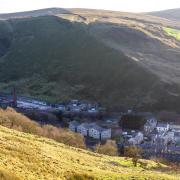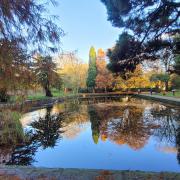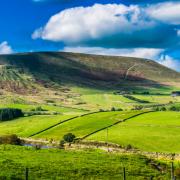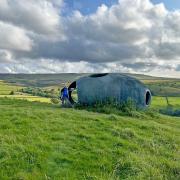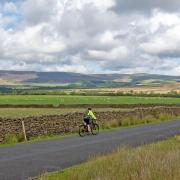Keith Carter leads a walk from Horwich which passes one of the region’s most recognisable sights

Our walk this month starts from the lane known as Wallsuches, parking near Curley’s Fishing Lake and restaurant. Wallsuches takes its name from the old bleaching and finishing works, once a thriving industry, now developed into tasteful housing. The lake is popular locally both for angling club members and day tickets, being well stocked with rainbow trout with a few pike to keep the strain healthy. Any weak or diseased trout help to keep the pike from getting hungry. One weighing 30 pounds has been caught here several times. There are a number of smaller lakes, former lodges for the bleach works, and these have carp, roach and tench in them.

The name Wallsuches derives from ‘well’ and ‘sok’ or as we would say ‘soak’, in other words descriptive of a wet and boggy area. Luckily we keep up onto the higher ground so don’t stray into any such areas.
To find Wallsuches if you don’t know it, head towards Bolton from Horwich on Chorley Old Road and turn in left at Ye Jolly Crofters pub where there is a lay-by which often has a snack caravan parked in it. You can park along the unsurfaced lane used by dog-walkers and those just out for a stroll. Curley’s has its own car park, usually quite full but I shouldn’t park there unless you intend using the restaurant which, I should add, is licensed but did not have draught beer at the time of my visit.
Any visit to this area requires a nod to the memory of Lord Leverhulme, industrialist and philanthropist, who purchased large tracts of land for the people of Bolton, his place of birth in 1851. He was a remarkable man. I once read that he would get up at 4am and do several hours work before the start of the working day, an example of how great men sleep less and work longer than ordinary mortals. I once had a boss who modelled himself on Leverhulme, ignoring the normal hours of work. My only complaint is that he expected everyone else to work the same hours as himself and it was unusual to finish before 10pm!
We start the walk along Wallsuches and before reaching a gate across it, we go up a flight of steps on the right, at the top of which we find one of the fishing lodges I mentioned earlier. Take the path along the left of it and we find ourselves beside a shoulder-high wall with a crenelated top like castle walls. Behind it is shown on the map as ‘Memorial Forest’ and this turns out to be Marklands, a plantation reserved planting trees in memory of loved ones, part of a series of similar sites collectively known as ‘Life for a Life’, initiated by United Utilities.
At a lane, cross over to an enclosed path that leads past stables to a group of dwellings including Harper’s Farm. The drive brings us out on a lane where we turn right then immediate left, a signpost pointing to Brinks Row. We walk beside Wilderswood, following the boundary wall of this enclosure of mature trees to meet a deep sunken way crossing our path. Keep right and enter the sunken lane which begins to climb, the going stony and damp.
At a crossroads maintain the same direction as the path becomes narrower, continuing its gradual climb to come finally to a flight of steps leading up to a crossing path. Turn left then immediate right on a path leading up through heather to link up with a cinder track, broad and wide. Turn left and walk as far as Pike Cottage housing Rivington Pike Dog Hotel.
At this point go up to the right through a kissing gate onto the open moor, the signpost saying Winter Hill which soon comes into sight, the mast seemingly disappearing into the clouds which it often does. At 1015 feet the television transmitter mast was erected in 1956 by the Independent Television Authority and replaced by the present mast in 1965. There have been sightings of UFOs on Winter Hill, none of them verified.
Our next objective is the pile of stones of Two Lads which should really be Three Lads since there are three cairns, although one may be of recent construction. The cairns are said to mark the graves of two boys who lost their lives here in a snowstorm.
From Two Lads, head for the Winter Hill service road and on reaching it, turn right and walk away from the mast until you see a gate on the left from where a clear path crosses moorland. Keep to this path and don’t stray leftwards into the boggy ground which is best avoided. The ridge-like escarpment is shown as Burnt Edge on the map but our path doesn’t take us onto it. Beyond the only farm, Slack Hall, our path comes to a meeting of ways and we join a road by turning right.
This is Matchmoor Lane and is our way back to Wallsuches. It climbs to a brow then begins a long descent, passing a riding stables then meeting a road coming up from the left from the main road. Cross directly over to a gap in the wall from where a steeply descending path brings us down to a row of cottages on Wallsuches. Turn left and we come back to where the car is parked near Curley’s.
We were about to take our sandwiches to the lake side for lunch when a fisherman pointed out it wasn’t a public right of way.
‘It’s for your own good,’ he assured us. ‘A cast line travels at the speed of light.’
‘But there’s nobody fishing.’
‘That’s not the point. You don’t want to lose an eye, do you?’
‘Ah. Health and safety?’
We ate them in the car. Mustn’t take any risks, must we?
Compass points
Area of walk: Horwich Moor
Distance: 4½ miles approx.
Time to allow: 2½-3 hours
Map: OS Explorer 287 West Pennine Moors
Refreshments: Curley’s restaurant, Ye Jolly Crofters pub
Not suitable for wheelchairs or pushchairs.




